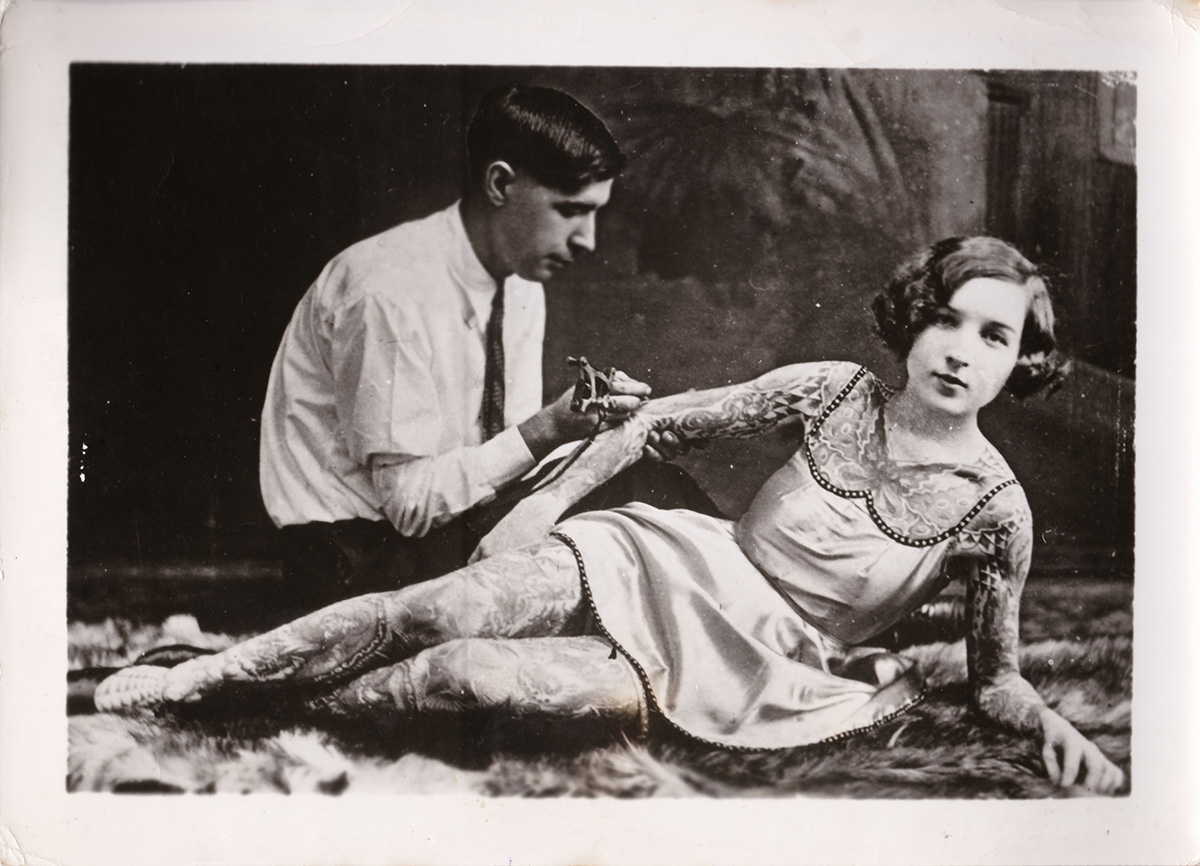100 Years of Tattoos
The NSFW visual history tracks the ever-changing nature of body art, from marks of protest to mainstream obsession


While last year’s Artbook/D.A.P. book “Tattoo” explored the art form’s global beginnings and its many cultural expressions, a new book, “100 Years of Tattoos,” focuses the lens on the recent history of body art. The meaning of tattoos—and the attitudes and perceptions surrounding them—has shifted rapidly as different generations experience changes in politics, beliefs and fashion, and author David McComb has put together a captivating narrative that is as informative as it is visually impactful.
The book starts in 1914, when soldiers and sailors fighting overseas in World War I used tattoos to show patriotism, be reminded of their loved ones, mark experience, and even as good-luck charms. After World War II, however, as a more “polite” Western society with a rapidly expanding middle class shunned tattoos, the art was embraced by those considered outsiders and worn as badges of protest and solidarity. The decades-long journey for tattoos to become socially accepted by the mainstream is fascinating—traversing the civil rights movement, improved sanitation and sterilization techniques, and music subcultures.

While McComb was working at the now defunct British alternative culture magazine Bizarre (which had space dedicated to tattoos and body modification) for the past decade, he also launched and edited two book series: “Body Art” and “The World’s Most Incredible Tattoos.” He tells CH, “When writing for Bizarre I was always on the lookout for the latest, cutting-edge body modification processes—but when writing ‘100 Years Of Tattoos,’ I had to reach into the past and explore the history of body art, and form a narrative based on the artwork and techniques developed by ink pioneers in the late 19th and 20th centuries.

In this 288-page tome, the focus is on the 300 archival illustrations and photos, with McCombs’ words as in-depth captions. “Although the development of body art in the West is pretty well-documented, finding images to illustrate the story I wanted to tell was a huge challenge,” notes McComb. “Tom Broadbent, the picture editor on the book, used many ingenious approaches to find the best images—from contacting tattooists directly to establishing links with archivists who’ve been collecting tattoo flash, photos and stories for decades. We also approached contributors via blogs, spoke to museum curators and called in lots of Bizarre favors to collect the images we needed—but it took a long time.”

The selected photos—many of which show NSFW nudity—are a stark contrast to the flirtatious peeks of tattoos we see in mainstream media today. McComb points out how artists such as Don Ed Hardy—inspired by the work of Japanese masters—created large-scale custom designs that used the entire body as a canvas. “Because of this, it was important for us to show full bodies and complete tattoos,” he says, “and illustrate how inventive work in the ’70s and ’80s laid the foundations for the multimillion dollar tattoo business we know today.”
Ink doesn’t have the same power to shock as it did in previous decades, and it’s unlikely it ever will again

So where are we now? “Modern tattoos are rarely used for political purposes—most of today’s body art is merely a form of adornment, or an attempt by the wearer to make a personal statement,” says McComb. “Although many tattooists are upset by how ink has been absorbed by mainstream culture—and a handful of artists are producing innovative, challenging and sometimes offensive work to try and take the practice back underground—ink doesn’t have the same power to shock as it did in previous decades, and it’s unlikely it ever will again. Anyone hoping to outrage now has to look to hardcore body modifications such as tongue-splitting or eyeball tattoos to cause a stir—but as soon as David Beckham and Angelina Jolie introduced tattoos to the masses in the late 1990s and early 2000s, the ancient art lost its status forever as the mark of an outsider.”

“100 Years of Tattoos” is set to publish this September 2015 via Laurence King; Amazon is currently accepting pre-orders for a 20 October 2015 delivery date.
Book cover image courtesy of Laurence King Publishing, third image (black and white) courtesy of Tattoo Archive, Winston, Salem, NC; second to last image courtesy of Fredi Macarini; all other images courtesy of Amsterdam Tattoo Museum












